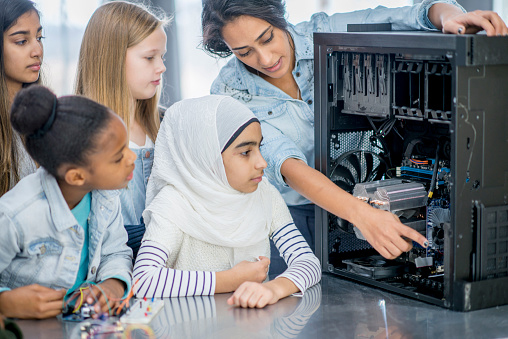Children are dreamers. When you ask children what they want to be when they grow up, the possibilities are endless! They want to be a professional athlete, or movie star or doctor. Theirs is an age where the only limitations are the ones they place on themselves. That’s why childhood is the perfect time to introduce them to STEM careers!
Of course, not everyone can become a famous basketball player or star in the next Avengers movie. However, this does not mean children must stop dreaming for the sake of practicality.
STEM Careers Still Needed
A career in science, technology, engineering and mathematics (STEM), embraces creativity and gives working professionals the freedom to innovate. Even at a young age, children are drawn to these sorts of jobs.
In a 2017 nationwide survey of over 1,000 boys and girls age 12 and younger, five of the top 10 of their dream jobs were STEM-related.
Yet, despite this high level of interest in STEM careers at a young age, millions of STEM jobs in the U.S. are currently unfilled and about 3.5 million STEM jobs will need to be staffed by 2025. That’s because children lose interest as they get older. Girls are especially losing interest in these fields as they age, as they comprised only 25% of the STEM workforce in 2015.
We must do a better job of supporting children’s interest in STEM from a young age, and it begins with encouragement and exposure to innovation.
Battling a Lack of Exposure to Innovation
Developing an inventive mindset at an early age is crucial to both pursuing and succeeding in a STEM career field. However, according to a 2017 study from the Equality of Opportunity Project, large disparities exist in innovation rates by socioeconomic class, race and gender.
The primary variable that determines whether a child will grow up to be an inventor is if they are exposed to innovation at a young age. Children from low-income and minority families are much less likely to have the opportunity to experience this exposure than children from white and/or affluent families. Because of this, students who fall under these demographics become much less interested in STEM fields compared to their counterparts as they grow up. The data backs this up:
- Children from high-income families are 10 times more likely to become inventors than children from low-income families.
- White children are three times more likely to become inventors than African-American children.
- 18% of patented inventors are female.
Channeling Creativity
Studies have also shown that those who participate in arts activities beginning at a young age are more likely to become innovators in adulthood.
Researchers from Michigan State University found a strong correlation between arts and crafts knowledge and producing patentable inventions or founding new companies. Furthermore, the majority of STEM graduate students surveyed believe the influence of the arts at an early age stimulated their innovation and entrepreneurship qualities.
Early arts exposure, combined with interactive STEM education, can attract students normally drawn to less technical subjects. This becomes increasingly important as legislators around the nation attempt to balance public school budgets by cutting art and music programs. Education in these subjects contributes to creating well-rounded students who are successful in both innovation and STEM fields.
Encouraging Girls in STEM
One of the main contributors to the low number of women working in STEM fields is the fact that there exist comparatively few female role models and mentors.
A 2017 study from Microsoft found that one of the main reasons girls chose not to follow a career in STEM was because they lacked a female role model. You can mitigate this by encouraging girls to participate in authentic science activities like simple experimentation, especially when led by female educators.
Challenging stereotypes of who can conduct science experiments allows girls to better identify with the field and reinvigorates their childhood interest in STEM subjects.
The Equality of Opportunity Project estimates the gender gap in innovation would “fall by half” if girls were exposed to female inventors as often as boys are to male inventors.
Introducing Children to Innovation
Introducing children to innovation as they mature is a leading factor in determining whether they will become inventors in adulthood. Those who grow up in families who embrace creative thinking are far more likely to pursue careers that allow them to use this skill set.
Additional exposure to STEM fields cannot be limited to formal education, as science in the classroom is sometimes overlooked until students reach middle school.
Only 4% of teachers for kindergarten through second grade earned undergraduate degrees in science or science education. This makes sense, as teachers for this age range are typically expected to be generalists, and not specialize in particular areas or subjects.
Embracing Out-of-Classroom Experiences
Out-of-school programs and summer camps make significant impacts on students’ futures in innovation, especially when they target children from underrepresented groups in the STEM industries.
These programs can help make up for the lack of exposure to innovation that minorities and low-income children receive due to the neighborhoods they grow up in. Outside exposure to STEM careers from experts and educators can guide children’s futures by inspiring them to follow their passions.
It’s not enough to tell kids they can become anything they want when they grow up. Instead, expose them to a wide array of skill sets at an early age to make informed decisions about what career field they’d most like to pursue.
Outside programming that allows students to explore STEM topics on their own is essential to sustaining interest over the long term. It’s important that instructors give students permission to take ownership of their own learning.
Only through exploration can children discover what STEM topics are most interesting to them as they age.
The National Inventors Hall of Fame® is a nonprofit with a mission to recognize inventors and invention, promote creativity and advance the spirit of innovation and entrepreneurship.





